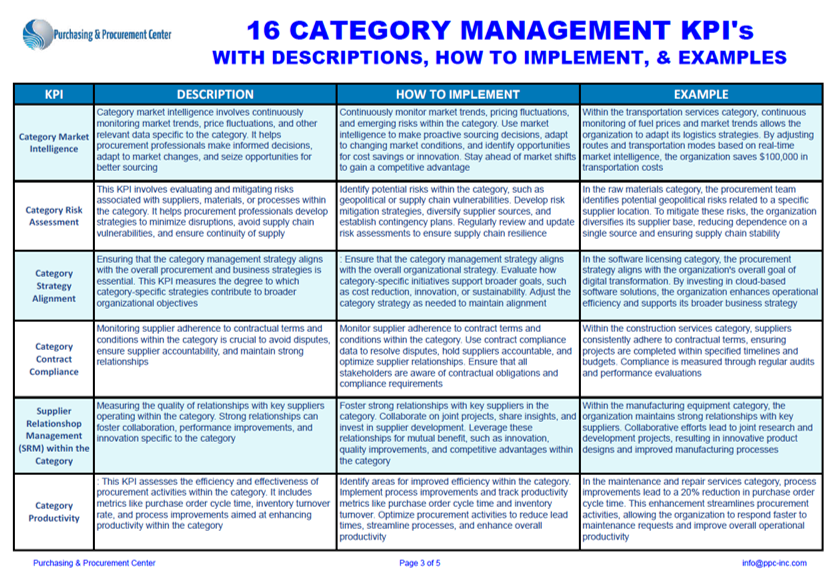- Home
- Services
- Certifications
- Trainings
- Testimonials
- Resources
- Videos on Demand
- E-Reports/Templates/Checklists
- Strategic Sourcing
- Category Management
- Purchasing Management
- Procurement Strategies
- Procurement Negotiations
- Cost Management
- Contract Management
- Legal Contract Terms
- Vendor Management
- RFX/Tender Management
- Global Sourcing
- Materials Management
- Inventory Control management
- About Us
16 CATEGORY MANAGEMENT KPIs TEMPLATE!
Comprehensive 16 KPIs Category Management Template - Includes Description, Instruction on How to Implement each KPI & Examples!

Get Your Digital Copy of the 4 Pages Template by Updating Your Name & Email at the Bottom!
You might like these also ...
The Multi-Phase Strategic Sourcing BluePrint Map
Free Strategic Sourcing BluePrint Map Summarizes in 1 Page the Full Sourcing Process
10 Steps Procurement Negotiations Checklist!
Download for Free the 10 Steps Procurement Negotiations Checklist, Including Description for each Step & When to Use and When Not Use each Step!
Download for Free the 7 Best Procurement Practices Blueprint!
Concise, No-nonsense Blueprint for Success, Highly Praised by Procurement Leaders. Straightforward & Actionable without Fluff, You'll Find it Invaluable!
5 Procurement Templates, Matrixes & Frameworks!
16 Category Management KPIs, 10 Step Negotiations, 7 Principles to Influence Stakeholders, Procurement Responsibility Matrix & 7 Best Procurement Practices
5 AI Prompts that will Transform Your Category Management!
AI Prompts that help you to: Create a matrix for the product/service you’re buying, Break down supplier costs, Options of sourcing from China or other countries
Download for Free the 7 Best Procurement Practices Blueprint!
Concise, No-nonsense Blueprint for Success, Highly Praised by Procurement Leaders. Straightforward & Actionable without Fluff, You'll Find it Invaluable!
10 Steps Procurement Negotiations Checklist!
Download for Free the 10 Steps Procurement Negotiations Checklist, Including Description for each Step & When to Use and When Not Use each Step!
Managing Indirect Procurement Categories & Overcoming 3 Key Challenges
How to Manage the 3 Indirect Procurement Categories & How to Overcome 3 Key Challenges When Managing these Indirect Procurement Categories?
Category Management in Procurement
The concept of “Category Management” was originated by retailers seeking to focus processes and people around the performance of categories......
Category Management and Strategic Sourcing
Uncover the Key Principles Behind Category Management and Strategic Sourcing! Including Differences, Challenges and 5 Strategies for Successful Implementation.
The Multi-Phase Strategic Sourcing BluePrint Map
Free Strategic Sourcing BluePrint Map Summarizes in 1 Page the Full Sourcing Process
Company & Services
Online Training/E-learning for Teams
Online Trainings for Individuals
About
Mission, Vision, Values
Contact
Procurement Topics & Resources
|
© 2010-2025 Purchasing & Procurement Center | All Rights Reserved |
Disclaimer | Privacy Policy | Payment Terms |Copyright Notice |






